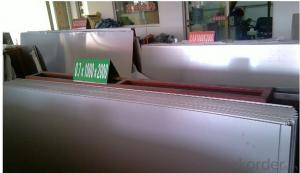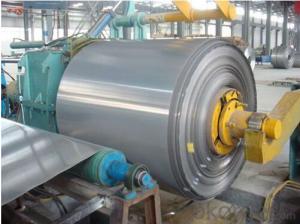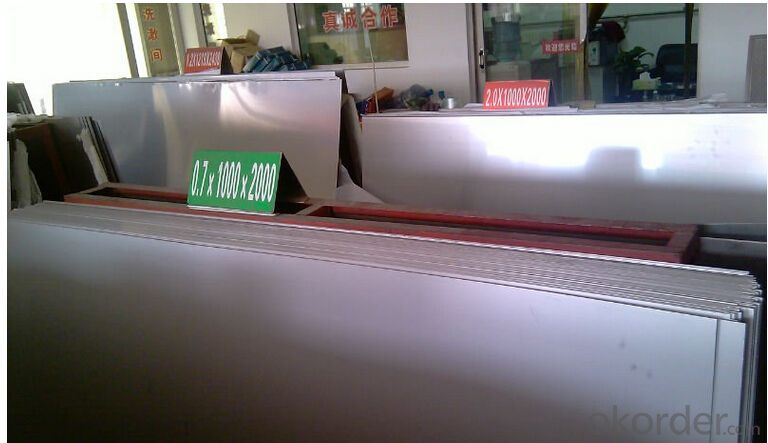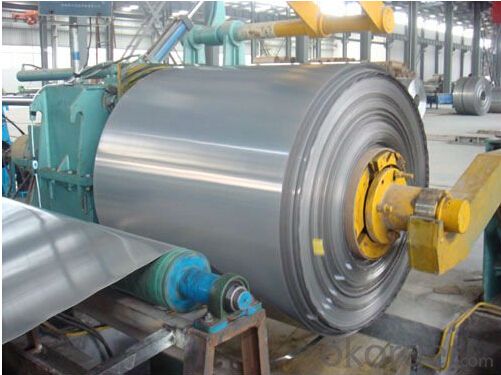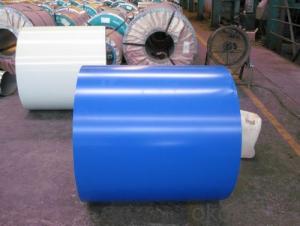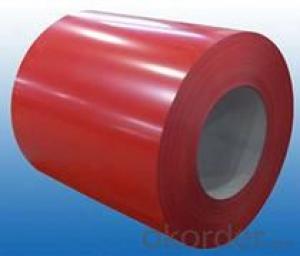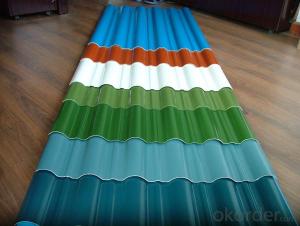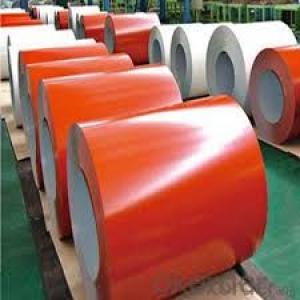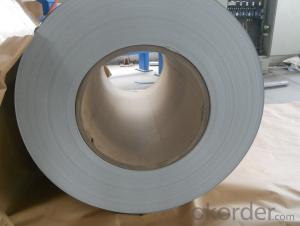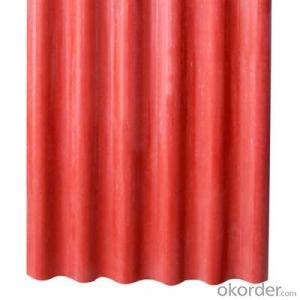Stainless Steel Sheet 317H, 347H Plate, 347H Sheet Coil
- Loading Port:
- China Main Port
- Payment Terms:
- TT or LC
- Min Order Qty:
- -
- Supply Capability:
- -
OKorder Service Pledge
OKorder Financial Service
You Might Also Like
Specifications
Best quality 316L sheet
bottom price and first-class service
Long-term golden supplier
0.35~100mm thickness
Length ordered
Our main products(Stainless steel plate/Stainless steel sheet) are as below.
Cold rolled stainless steel plate and coil
Dimension | Grade | Finish |
0.4mmx1000/1219mm | 304/304L/321/316L/310S/309S/347H/317L/631/904L/2205 | 2B/HL/NO.4/8K/BA |
0.5mmx1000/1219mm | 304/304L/321/316L/310S/309S/347H/317L/631/904L/2205 | 2B/HL/NO.4/8K/BA |
0.6mmx1000/1219mm | 304/304L/321/316L/310S/309S/347H/317L/631/904L/2205 | 2B/HL/NO.4/8K/BA |
0.7mmx1000/1219mm | 304/304L/321/316L/310S/309S/347H/317L/631/904L/2205 | 2B/HL/NO.4/8K/BA |
0.8mmx1000/1219mm | 304/304L/321/316L/310S/309S/347H/317L/631/904L/2205 | 2B/HL/NO.4/8K/BA |
0.9mmx1000/1219mm | 304/304L/321/316L/310S/309S/347H/317L/631/904L/2205 | 2B/HL/NO.4/8K/BA |
1.0mmx1000/1219/1500mm | 304/304L/321/316L/310S/309S/347H/317L/631/904L/2205 | 2B/HL/NO.4/8K/BA |
1.2mmx1000/1219/1500mm | 304/304L/321/316L/310S/309S/347H/317L/631/904L/2205 | 2B/HL/NO.4/8K/BA |
1.5mmx1000/1219/1500mm | 304/304L/321/316L/310S/309S/347H/317L/631/904L/2205 | 2B/HL/NO.4/8K/BA |
2.0mmx1000/1219/1500mm | 304/304L/321/316L/310S/309S/347H/317L/631/904L/2205 | 2B/HL/NO.4/8K/BA |
2.5mmx1000/1219/1500mm | 304/304L/321/316L/310S/309S/347H/317L/631/904L/2205 | 2B/HL/NO.4/8K/BA |
3.0mmx1000/1219/1500mm | 304/304L/321/316L/310S/309S/347H/317L/631/904L/2205 | 2B/HL/NO.4/8K/BA |
4.0mmx1500mm | 304/304L/321/316L/310S/309S/347H/317L/631/904L/2205 | 2B/HL/NO.4/8K/BA |
5.0mmx1500mm | 304/304L/321/316L/310S/309S/347H/317L/631/904L/2205 | 2B/HL/NO.4/8K/BA |
6.0mmx1500mm | 304/304L/321/316L/310S/309S/347H/317L/631/904L/2205 | 2B/HL/NO.4/8K/BA |
Hot rolled stainess steel plate and coil
Dimension | Grade | Finish |
3.0mmx1240/1500mm | 304/304L/321/316L/310S/309S/347H/317L/631/904L/2205 | NO.1/1D/HL/NO.4/8K |
4.0mmx1240/1500mm | 304/304L/321/316L/310S/309S/347H/317L/631/904L/2205 | NO.1/1D/HL/NO.4/8K |
5.0mmx1240/1500mm | 304/304L/321/316L/310S/309S/347H/317L/631/904L/2205 | NO.1/1D/HL/NO.4/8K |
6.0mmx1500mm | 304/304L/321/316L/310S/309S/347H/317L/631/904L/2205 | NO.1/1D/HL/NO.4/8K |
8.0mmx1500mm | 304/304L/321/316L/310S/309S/347H/317L/631/904L/2205 | NO.1/1D/HL/NO.4/8K |
10.0mmx1500/1800mm | 304/304L/321/316L/310S/309S/347H/317L/631/904L/2205 | NO.1/1D/HL/NO.4/8K |
12.0mmx1500/1800/2000mm | 304/304L/321/316L/310S/309S/347H/317L/631/904L/2205 | NO.1/1D/HL/NO.4/8K |
14.0mmx1500/1800/2000mm | 304/304L/321/316L/310S/309S/347H/317L/631/904L/2205 | NO.1/1D/HL/NO.4/8K |
16.0mmx1500/1800/2000mm | 304/304L/321/316L/310S/309S/347H/317L/631/904L/2205 | NO.1/1D/HL/NO.4/8K |
18.0mmx1500/1800/2000mm | 304/304L/321/316L/310S/309S/347H/317L/631/904L/2205 | NO.1/1D/HL/NO.4/8K |
20.0mmx1500/1800/2000mm | 304/304L/321/316L/310S/309S/347H/317L/631/904L/2205 | NO.1/1D/HL/NO.4/8K |
The thickness above 20mm, we can manufacture for you according to your requirement. | ||
FAQ of Stainless Steel Coil:
①How is the quality of your products?
Our products are manufactured strictly according to national and internaional standard, and we take a test on every coil before delivered out. If you want see our quality certifications and all kinds of testing report, please just ask us for it.
Guaranteed: If products’ quality don’t accord to discription as we give or the promise before you place order, we promise 100% refund.
②How about price?
Yes, we are factory and be able to give you lowest price below market one, and we have a policy that “ for saving time and absolutely honest business attitude, we quote as lowest as possible for any customer, and discount can be given according to quantity”,if you like bargain and factory price is not low enough as you think, just don’t waste your time.Please trust the quotation we would give you, it is professional one.
③Why should you chose us?
Chose happens because of quality, then price, We can give you both.Additionally, we can also offer professional products inquiry, products knowledge train(for agents), smooth goods delivery, exellent customer solution proposals.Our service formula: good quality+good price+good service=customer’s trust
SGS test is available, customer inspection before shipping is welcome, third party inspection is no problem.
Any question, pls feel free to contact us !
Stainless Steel Coil Images:
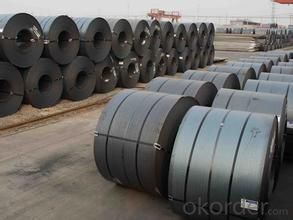
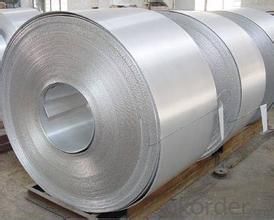
- Q: How are steel coils used in the production of industrial storage tanks?
- Steel coils are commonly used in the production of industrial storage tanks due to their superior strength and durability. These coils are typically made from high-quality steel that is rolled into a coil shape, allowing for easy transportation and handling. In the production process, steel coils are first uncoiled and flattened to create sheets of steel. These sheets are then cut and formed into the desired shape and size for the storage tank. The steel sheets are welded or bolted together to create the tank's body, which is designed to withstand high pressure and heavy loads. The use of steel coils in the production of industrial storage tanks offers several advantages. Firstly, the strength and durability of steel ensure that the tanks can withstand harsh conditions and are resistant to corrosion. This is particularly important for storage tanks that may contain corrosive substances or be exposed to harsh environments. Additionally, the flexibility of steel coils allows for customization of the tank's design and size. This is particularly beneficial in industries where storage requirements can vary significantly, such as the oil and gas industry. Steel coils can be easily cut and formed into various shapes and sizes, enabling the production of storage tanks that meet specific storage needs. Furthermore, steel coils can be easily transported and stored, making them a cost-effective choice for the production of industrial storage tanks. The coils can be efficiently transported to the manufacturing facility, reducing transportation costs and logistical complexities. Overall, steel coils play a crucial role in the production of industrial storage tanks by providing strength, durability, and customization options. Their use ensures that the tanks can safely store and protect various substances, making them essential for a wide range of industries.
- Q: What is the best butcher's steel around $20? I'm looking for a good tool to straight out some kitchen knives. thanks
- Not really. Unless your knives are remarkably rusty and chipped, cleaning the knife after the steel will do little. It is possible that you are consuming an immeasurable amount of metal, but then again you're probably consuming a little from everything the food touches. Thats just the way it is and it is nothing to be worried about.
- Q: Why buy recycled steel and from where to buy?
- Where you buy all your steel. The recycled and new steel are indistinguishable from each other. You won't recognize the one from the other. Same thing with glass. A certain percentage must be used glass, to enhance the quality of the total batch. Peace.
- Q: How are steel coils processed and shaped for specific applications?
- Steel coils are processed and shaped for specific applications through a series of manufacturing processes. These processes typically include cleaning, pickling, cold rolling, annealing, and slitting. Cleaning removes any surface impurities, pickling removes scale and oxides, cold rolling reduces the thickness and enhances the strength, annealing improves ductility and reduces hardness, and finally, slitting cuts the coils into desired widths. These steps ensure that steel coils are transformed into the appropriate shape and size required for specific applications, such as in construction, automotive, or manufacturing industries.
- Q: How are steel coils used in the production of automobile frames?
- Automobile frames rely heavily on steel coils, which are indispensable for their production. These coils, crafted from top-notch steel, undergo a process of uncoiling before being fed into a stamping press, where they assume various forms, constituting parts of the frame. The presence of steel coils is crucial as they furnish the frame with the requisite strength and rigidity, ensuring it can bear the vehicle's weight and maintain structural integrity. Once shaped, the coils are frequently welded together to construct the frame structure. This welding procedure securely binds the individual components, guaranteeing that the frame can endure the forces and strains encountered during the vehicle's operation. Utilizing steel coils in the production of automobile frames also allows for design flexibility, as they can be effortlessly shaped and manipulated to fulfill specific requirements. Moreover, steel coils possess exceptional durability and corrosion resistance, rendering them ideal for automotive applications. Frames fashioned from these coils are not only robust and dependable but also capable of withstanding harsh conditions and road vibrations. This not only enhances the vehicle's safety but also contributes to its longevity and overall performance. Steel coils also find use in other critical vehicle components, including suspension systems, chassis, and body panels. Their versatility, strength, and cost-effectiveness make them a favored choice in the automotive industry. Overall, the incorporation of steel coils in automobile frame production plays a significant role in guaranteeing the safety, durability, and performance of modern vehicles.
- Q: What are the common coil transportation options?
- The common coil transportation options include trucking, rail transport, and sea freight.
- Q: Can steel coils be coated with vibration-damping materials?
- Yes, steel coils can be coated with vibration-damping materials. These materials, such as rubber-based compounds or specialty coatings, can help reduce vibrations and dampen the noise generated by the steel coils during operation.
- Q: How are steel coils used in the manufacturing of electrical appliances?
- Steel coils are used in the manufacturing of electrical appliances primarily for their magnetic properties. These coils are wound around a core to create electromagnets, which are essential components in various appliances like transformers, motors, generators, and solenoids. The magnetic field generated by the steel coils allows for the efficient conversion of electrical energy into mechanical energy or vice versa, enabling the proper functioning of these appliances.
- Q: How are steel coils used in the manufacturing of railway equipment?
- Steel coils are a crucial component in the manufacturing of railway equipment due to their strength, durability, and versatility. These coils are typically made from high-quality steel and are extensively used in various applications throughout the railway industry. One primary use of steel coils in the manufacturing of railway equipment is in the production of train tracks. Steel coils are rolled out and shaped into long, continuous rails that form the foundation of railway tracks. The strength and durability of these coils enable the tracks to withstand heavy loads, constant train traffic, and harsh weather conditions. Additionally, the uniformity and consistency of steel coils ensure smooth and safe train operations. Furthermore, steel coils are also used in the manufacturing of railway wagons and carriages. These coils are formed and shaped into various components such as the framework, body panels, and structural supports of the wagons. The robustness of steel coils ensures the structural integrity of the wagons, enabling them to carry heavy cargo and withstand the rigors of railway transportation. Moreover, steel coils are utilized in the fabrication of various railway equipment accessories, including couplings, brake systems, and suspension components. These coils are transformed into precise shapes and sizes to meet the specific requirements of each accessory. The strength and resilience of steel coils make them ideal for these critical parts, ensuring efficient and safe operation of the railway equipment. In summary, steel coils play a vital role in the manufacturing of railway equipment. Their strength, durability, and versatility make them an essential material for the construction of train tracks, wagons, carriages, and various accessories. The use of steel coils ensures the safety, reliability, and longevity of railway equipment, making them an integral part of the railway industry.
- Q: Its big and expensive and i don't know if it would have a logical purpose but its sharp as hell and awesome. Anyways, its made from surgical steel and all i have found on the internet is that its probably 316L (w/e that means). I have another knife made from 440 stainless steel and as far as i know that is pretty much the hardest stainless metal. So why would the more expensive one be made from surgical steel?
- Unfortunately okorder /
Send your message to us
Stainless Steel Sheet 317H, 347H Plate, 347H Sheet Coil
- Loading Port:
- China Main Port
- Payment Terms:
- TT or LC
- Min Order Qty:
- -
- Supply Capability:
- -
OKorder Service Pledge
OKorder Financial Service
Similar products
Hot products
Hot Searches
Related keywords
